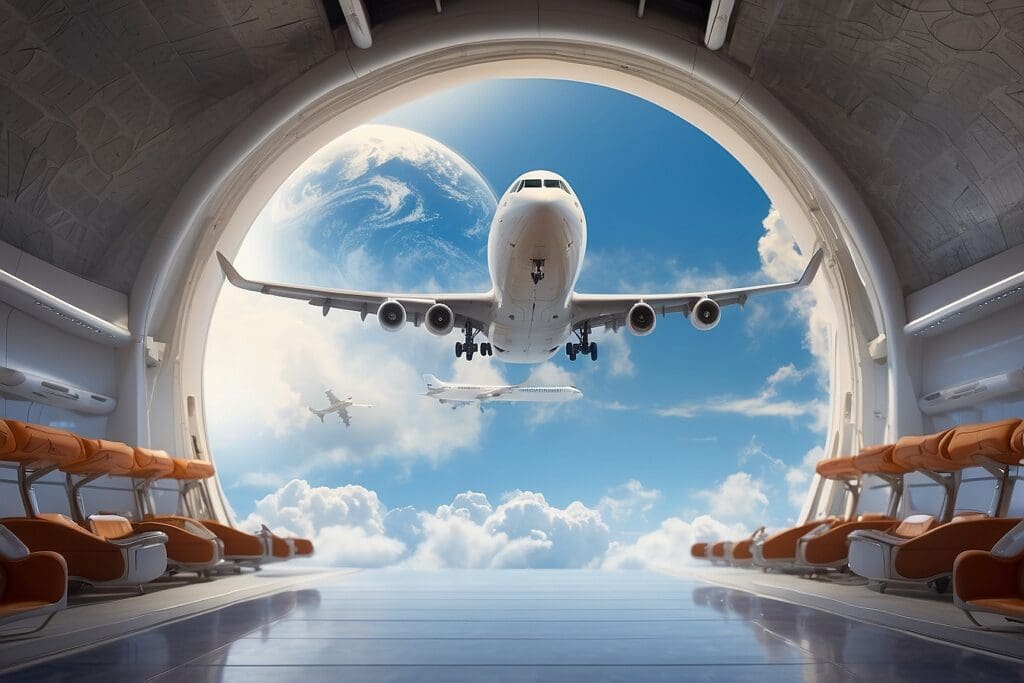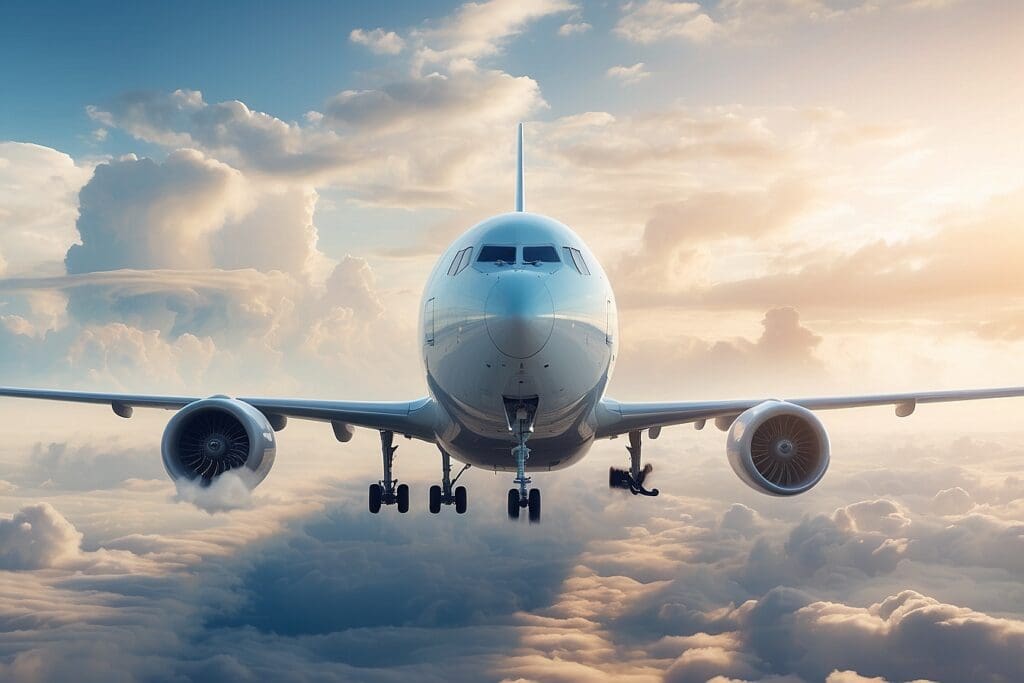For several years now, air travel’s detrimental impact on climate change, specifically global warming ![]() , has been in the spotlight. However, will climate change in turn have an impact on air travel? Recent research points to yes.
, has been in the spotlight. However, will climate change in turn have an impact on air travel? Recent research points to yes.
Overview of Air Travel’s Environmental Impacts
While airplanes have revolutionized the way that humans travel, they have several negative environmental impacts. First, airplanes emit carbon dioxide ![]() , water vapor, nitrous oxides, sulphate, and soot. In addition, studies have shown that high-altitude emissions have a more harmful impact due to the specific chemical reactions that occur at high altitude.1 In terms of carbon dioxide emissions, one round-trip flight between New York and San Francisco has a warming effect of approximately 2-3 tons of carbon dioxide per person into the atmosphere. Since flying is becoming more accessible, the number of flights is projected to increase at a faster rate than airplane fuel efficiency is expected to be improved. Environmental consultant Anja Kollmuss stated of air travel, “For many people…who don’t drive much and live in apartments, this is probably going to be by far the largest part of their carbon footprint.”2
, water vapor, nitrous oxides, sulphate, and soot. In addition, studies have shown that high-altitude emissions have a more harmful impact due to the specific chemical reactions that occur at high altitude.1 In terms of carbon dioxide emissions, one round-trip flight between New York and San Francisco has a warming effect of approximately 2-3 tons of carbon dioxide per person into the atmosphere. Since flying is becoming more accessible, the number of flights is projected to increase at a faster rate than airplane fuel efficiency is expected to be improved. Environmental consultant Anja Kollmuss stated of air travel, “For many people…who don’t drive much and live in apartments, this is probably going to be by far the largest part of their carbon footprint.”2
Second, while air travel is a wonderful achievement, it is an achievement that was made possible by solar ![]() power.4
power.4
Air Travel’s Impact on Climate Change

Air travel’s reliance on fossil fuels, which leads to greenhouse gas emissions, is indeed troubling. However, the reverse impact – climate change’s impact on air travel – is also important and researchers are finally beginning to conduct studies on this matter. The Woods Hole Oceanographic Institution published a study in July 2015 that showed increased flight times between Hawaii and the United States mainland due to the shifting of the jet stream over the Pacific Ocean.5 Researchers believe that climate change is causing these Pacific Ocean wind patterns to change. Longer flights will burn more fossil fuel, causing more carbon dioxide to be released into the atmosphere, which will continue to contribute to global warming. It will be difficult to break this cycle without finding an alternative fuel source.6
In addition to longer flights and more emissions ![]() , studies have found that flights in the future may experience more moderate turbulence due to climate change. The two main types of turbulence are storm and clear-air. While flying through storm clouds causes turbulence, jet streams in seemingly clear skies can also cause bumpiness. Atmospheric scientist Paul Williams said of clear-air turbulence, “The pilot can’t see it and the sensors onboard can’t see it—that’s why it’s a particularly dangerous form of turbulence.” Climate change is currently accelerating the speed of the North Atlantic jet stream, which makes the jet stream more susceptible to turbulent air. Flight attendants who are moving about the plane are the people most at risk for becoming injured during moderate turbulence.7
, studies have found that flights in the future may experience more moderate turbulence due to climate change. The two main types of turbulence are storm and clear-air. While flying through storm clouds causes turbulence, jet streams in seemingly clear skies can also cause bumpiness. Atmospheric scientist Paul Williams said of clear-air turbulence, “The pilot can’t see it and the sensors onboard can’t see it—that’s why it’s a particularly dangerous form of turbulence.” Climate change is currently accelerating the speed of the North Atlantic jet stream, which makes the jet stream more susceptible to turbulent air. Flight attendants who are moving about the plane are the people most at risk for becoming injured during moderate turbulence.7
Future of Air Travel
In June 2015, the United States Environmental Protection Agency (EPA) finally took its first step in airplane greenhouse gas regulation, something it has already done for motor vehicles and power plants ![]() . However, due to lobbying from airlines and waiting for current international negotiations on this matter to play out, requirements are not likely to be finalized for several more years. Christopher Grundler, director of the EPA’s Office of Transportation and Air Quality, states, “Our No. 1 goal is to secure a meaningful international standard…An international policy would secure far more greenhouse gas emissions reductions than a domestic-only plan.” However, environmental groups are concerned that the eventual standards will not be strict enough. On the other side, some worry that strict standards will raise the price of airfare too much and hurt domestic carriers.8
. However, due to lobbying from airlines and waiting for current international negotiations on this matter to play out, requirements are not likely to be finalized for several more years. Christopher Grundler, director of the EPA’s Office of Transportation and Air Quality, states, “Our No. 1 goal is to secure a meaningful international standard…An international policy would secure far more greenhouse gas emissions reductions than a domestic-only plan.” However, environmental groups are concerned that the eventual standards will not be strict enough. On the other side, some worry that strict standards will raise the price of airfare too much and hurt domestic carriers.8
On an individual level, if you are not excited about the prospect of shunning air travel altogether, some airlines now offer a clear-cut ![]() for other uses, thus avoiding the emission of over 445,000 metric tons of carbon dioxide. Professor Geoffrey Heal states, “If you’re a traveler and you’re greenhouse gas conscious, then this is a legitimate way of creating an offset.” However, Heal adds, “If everybody did it all the time, it would help. The problem is that very few people do it, and the people that do it don’t do it all the time.”9
for other uses, thus avoiding the emission of over 445,000 metric tons of carbon dioxide. Professor Geoffrey Heal states, “If you’re a traveler and you’re greenhouse gas conscious, then this is a legitimate way of creating an offset.” However, Heal adds, “If everybody did it all the time, it would help. The problem is that very few people do it, and the people that do it don’t do it all the time.”9
For more information on the relationship between air travel and the environment, visit: Airline Industry ![]()





